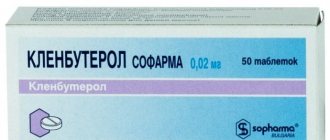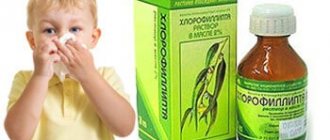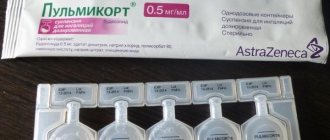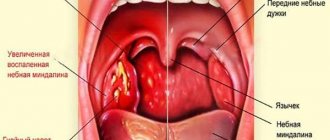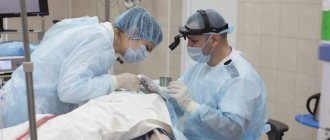ESR is a nonspecific indicator. When conducting a blood test, the rate at which its fractions precipitate is determined, among other things. During inflammation, the ESR is increased due to the increased protein content. Can this help make a diagnosis?
It is impossible to find out what exactly caused this reaction of the body using just one indicator. And yet, the erythrocyte sedimentation rate is determined in almost any disease. It allows you to install:
- The presence of an inflammatory process.
- Degree of inflammation.
- Response to antibacterial or anti-inflammatory therapy.
ESR is only an indirect sign of these conditions, but its practical significance is still great. And many doctors prefer to focus on this value when prescribing or adjusting treatment. So, if the sedimentation rate was increased and began to decrease during therapy, the medicine was chosen correctly.
In children, this indicator can vary to varying degrees.
ESR
The abbreviation ESR stands for “erythrocyte sedimentation rate.” Sometimes on the forms you can find another abbreviation - ESR (erythrocyte sedimentation reaction).
This indicator shows how quickly or slowly red blood cells settle under the influence of gravity in blood that does not clot. The rate of the phenomenon depends on the ratio of plasma proteins.
Thus, changes in ESR indicate a certain pathological process. Most often this is inflammation.
ESR for colds
With a cold, runny nose, cough, or sore throat, red blood cells will almost always precipitate quickly. This will lead to an increase in ESR.
In healthy women, the rate ranges from 2 to 15 mm/hour, in men - from 1 to 10. In children, the same numbers are observed. Laboratory standards may change; sometimes the upper limit is an ESR of 20 mm/hour. Anything above this value is considered pathological.
With the common cold, there is no sharp increase in sedimentation rate. It can increase to 20–25 mm/hour, rarely higher. If ARVI is complicated by bronchitis, pneumonia or pleurisy, ESR can reach 30 or even 40 mm/hour.
Although this indicator is nonspecific, it is widely used to determine the severity of a cold. Also, the dynamics of ESR serves as a criterion for recovery or, conversely, deterioration of the condition.
A sudden increase in ESR with a common runny nose and cough is a reason for a more detailed examination, as it indicates a strong inflammatory process. Such a patient must undergo an x-ray of the chest organs and paranasal sinuses.
After a cold, the ESR will remain elevated for some time – up to 1–2 weeks.
Other reasons for changes in ESR
ESR can increase not only with a cold, but also with other diseases that sometimes occur in parallel with ARVI. This should not be forgotten.
The most common reasons for an increase in the indicator are:
- Inflammatory processes of non-infectious etiology (for example, arthritis).
- Anemia.
- Autoimmune diseases (systemic lupus erythematosus, scleroderma, rheumatoid arthritis).
- Thyrotoxicosis.
- Malignant neoplasms.
With such pathologies, ESR is usually significantly increased. So, with lung cancer it can reach 60–70 mm/hour.
If, against the background of a common cold, there is an inadequate increase in the indicator or it does not decrease for a long time after recovery, this is a reason for a detailed examination and consultation of related specialists.
To diagnose the causes and determine the clinical form of bronchial inflammation, laboratory tests of blood and sputum are required. Based on the test results for bronchitis in adults, further treatment tactics are determined. Diagnostic measures make it possible to identify and exclude severe infectious diseases, thereby preventing the development of life-threatening conditions.
ESR analysis for bronchitis
If a patient is suspected of having bronchitis in acute, chronic or obstructive form, the doctor will definitely write out a referral for biochemical and general blood tests.
ESR for bronchitis is one of the main points in the analysis, thanks to which the doctor will be able to establish an accurate diagnosis. If a patient is suspected of having bronchitis, the doctor will definitely write a referral for biochemical and general blood tests.
What is ESR
ESR (erythrocyte sedimentation rate), along with the level of leukocytes in the blood, is the first indicator that responds to the inflammatory process in the lungs and bronchi.
ESR makes it possible to determine the onset of inflammation not only in the respiratory system, but also in any other system of the body even before the patient feels the first signs of illness. ESR is an indicator of a natural biochemical process. The speed of this process increases several times as soon as pathogenic bacteria begin to operate in the body.
ESR is the first indicator that responds to the inflammatory process in the lungs and bronchi.
Indications for testing
A blood test for this indicator is prescribed to patients of all ages if they suspect any form of bronchitis. The erythrocyte sedimentation rate will be of great importance for making a diagnosis if an adult or child has the following symptoms:
- difficulty breathing, pain or discomfort when air passes through the respiratory tract;
- cough and shortness of breath;
- yellow or green sputum;
- increased body temperature, runny nose, headache.
ESR is of particular importance in cases where the patient has a headache, fever, cough and shortness of breath.
How to prepare for analysis
To obtain reliable results from this study, you will have to adhere to a number of rules before submitting the analysis. So, you are allowed to donate blood only in the morning on an empty stomach. The last meal in both adult patients and children should be in the evening of the previous day. In the morning before the procedure, you can only drink a small amount of water. An exception can be made only for infants. Children under one year old can be tested for ESR just a few hours after eating.
48 hours before the procedure, you should avoid sports and any physical and emotional stress. It is also recommended to adjust your diet by removing all fatty and spicy foods. You will have to abstain from foods high in carbohydrates, alcohol, tea and coffee.
Before taking the test, it is prohibited to undergo fluorography and physiotherapeutic procedures.
You should not take medications that can change the composition of your blood or hormonal contraceptives. If it is impossible to completely stop taking any medication a few days before the procedure, you should inform your doctor.
Decoding the results
In a healthy adult man, the ESR can be 1-10 mm/h, in a woman - 2-15 mm/h. In children, its value should not exceed 17 mm/h. If the ESR exceeds 100 mm/h, this may indicate the presence of pneumonia or tuberculosis. Examination of other blood parameters will also help establish the cause of bronchitis.
Sources used: bronhitoff.ru
ARTICLES ON THE TOPIC: Onions for bronchitis and cough in adults Goat fat for bronchitis in adults What is the name of a bronchitis doctor Cold inhalations for bronchitis Can the voice disappear with bronchitis
Blood
Bronchitis is a polyetiological disease, the development of which can be caused by a large number of reasons. The main laboratory blood test for bronchitis is a clinical analysis, which determines the following indicators:
- Hemoglobin level.
- The number of leukocytes, erythrocytes, platelets.
- ESR (erythrocyte sedimentation rate).
- Leukocyte formula.
The main blood test indicators differ depending on the form of bronchitis. Let's look at some of them below.
Bacterial bronchitis – inflammation of the bronchi is caused by various types of pathogenic and conditionally pathogenic bacteria. In a clinical blood test, the number of leukocytes increases, mainly due to neutrophils (counting is carried out in the leukocyte formula).
Viral bronchitis is a disease that develops against the background of the activity of viruses in the cells of the bronchial mucosa and usually accompanies ARVI (acute respiratory viral infection). At the same time, in a clinical blood test, the number of red blood cells may be normal or slightly reduced, but lymphocytes (a marker of the development of a viral infection) prevail in the leukocyte formula. ESR also increases during bronchitis, but hemoglobin and the number of red blood cells remain unchanged.
Allergic bronchitis - a specific hypersensitization reaction develops in the bronchi, provoked by the ingestion of foreign compounds, mainly of protein origin (allergens). These include house dust, plant pollen, aerosols of various chemical compounds, including cosmetics or household chemicals.
Allergies do not develop in everyone, but only in people with changes in the functional state of the immune system, which are often of hereditary origin. Specific inflammation is accompanied by spasm of the bronchi, increased activity of the glands of the mucous membrane, as a result of which periodic paroxysmal cough and severe shortness of breath develop.
In the blood, there is an increase in ESR, a slight leukocytosis (increase in the number of white blood cells) due to eosinophilia (increase in the number of eosinophils, which is a marker of allergic reactions in the body).
To diagnose chronic or obstructive bronchitis, neuroimaging methods are used, which you can read about in this article.
The cost of tests for bronchitis with the study of blood parameters depends on several factors:
- The number of indicators determined in the analysis (study with or without leukocyte formula).
- Methodology of analysis - automated studies using special analyzers are highly reliable, but are more expensive.
- Pricing policy of the clinical diagnostic laboratory in which the research is carried out.
How to determine the level of ESR during bronchitis?
Content
The level of ESR during bronchitis, like other indicators, the level of which in the blood is changed by tests during the course of the disease, significantly deviates from the norm. It is important to take this into account when interpreting the results obtained in order to correctly assess how severe the inflammation is and whether it is subsiding.
The ESR itself, i.e. the rate at which red blood cells settle is not the most important indicator of all analyzed and can fluctuate due to the influence of various factors, but its increase almost unambiguously indicates the course of inflammatory processes in the body.
Bronchitis: causes and symptoms
With bronchitis, the mucous membranes of the respiratory system become inflamed, so its main danger is obstruction of air circulation. Accordingly, the availability of oxygen in the blood is also significantly reduced, and this can cause serious complications.
There are several types of disease:
In all cases, a blood test is one of the best ways to both directly diagnose the disease and monitor the progress of treatment and its effect on the body.
Exceptions to the rules
The penetration of tuberculosis and syphilis bacteria into the human body is accompanied by a slight increase in the number of lymphocytes and monocytes, which is typical for infections of viral etiology. This also happens with the development of fungal microflora.
A significant increase in ESR indicates the presence of malignant tumors, heart attacks, dysfunction of the endocrine glands, kidneys, liver, and autoimmune diseases.
A strong increase or decrease in the level of white blood cells indicates leukemia or leukopenia. In this case, bacterial and viral infections do not play a role, since these pathologies can be caused by long-term antiviral or chemotherapy, radiation exposure and other factors.
Reasons for an increase in ESR in a child
The body of children traditionally differs from that of an adult in terms of laboratory test results. The erythrocyte sedimentation rate is no exception, the growth of which in a child is provoked by a slightly modified list of prerequisites.
In most cases, an increased ESR in the blood of a child indicates the presence of an infectious-inflammatory process in the body. This is often confirmed by other results in a general blood test, which, together with ESR, almost immediately form a picture of the child’s condition. Moreover, in a small patient, an increase in this indicator is often accompanied by a visual deterioration of the condition: weakness, apathy, lack of appetite - a classic picture of an infectious disease with the presence of an inflammatory process.
Of the non-infectious diseases that most often provoke increased ESR in a child, the following should be highlighted:
- bronchial asthma;
- pulmonary and extrapulmonary forms of tuberculosis;
- anemia and blood diseases;
- diseases associated with metabolic disorders;
- injuries.
However, if an increased ESR is detected in a child, the reasons may be quite harmless. In particular, going beyond the normal range of this indicator can be triggered by taking paracetamol - one of the most popular antipyretics, teething in infants, the presence of worms (helminth infections), and a deficiency of vitamins in the body. All these factors are also false positives and should be taken into account at the stage of preparation for a laboratory blood test.
The main symptoms of the difference between a bacterial and an early viral infection
All viral infections have approximately the same symptoms. The most characteristic are:
- After three days, signs of infection appear;
- Intoxication lasts two days;
- A viral allergy appears;
- The temperature is rising.
The first symptoms of a viral infection include:
- Rhinitis;
- Pharyngitis;
- Conjunctevitis.
Bacteria develop much more slowly. Quite often there is a layering of a bacterial infection on an existing viral disease. The main symptoms of a bacterial infection are:
- Delayed onset;
- The first signs appear after two weeks;
- Low temperature;
- Presence of a lesion.
Common types of flu strains
Influenza A strains
One of the most dangerous pathogens.
- They are quickly and easily transmitted from an infected person to a healthy person, and even animals can be affected.
- This type of flu constantly mutates and becomes more resistant to medications.
The name of the virus strain that caused an entire pandemic in 2009.
- The clinical picture is similar to strain A, but it always causes severe complications in the lungs.
H5N1 – avian influenza
The peculiarity of this type is that mortality is approximately 70% of all cases.
- And the virus also continues to change, becoming more resistant to drugs.
Influenza B strains
This group poses less of a threat to human life, but still remains dangerous. The disease is more easily tolerated, and the virus practically does not mutate.
Flu C
Cases of infection are isolated, and most often the disease occurs in a mild, asymptomatic form. Epidemics in this case are rare.
How and why to distinguish a band neutrophil from a segmented one?
It turns out that this is very easy to do with your eyes, but almost impossible to determine using a machine. That is why it is worth doing not just a general blood test, but a general blood test with microscopy, i.e. with manual examination. Let’s imagine a situation: you or your child have had a fever for the fifth day, you did a general blood test with microscopy. According to the results, the level of band neutrophils is overestimated. This means that the disease is not viral, but a bacterial complication. And in this case, the pediatrician or therapist understands that it is time to give antibiotics. If you start taking them earlier - when the disease is viral - antibiotics will not only not help fight the infection, but will also weaken the immune system. This will weaken the body and the risk of bacterial complications will increase several times.
Not every case of elevated ESR is due to an ongoing disease
Author: Content · Published 07/15/2015 · Updated 10/17/2018
Currently, medicine has broad capabilities, however, for a certain type of diagnostics, research methods developed almost a century ago have still not lost their relevance. The indicator (erythrocyte sedimentation rate), previously called (erythrocyte sedimentation reaction), has been known since 1918. Methods for measuring it have been defined since 1926 (according to Westergren) and 1935 according to Winthrop (or Wintrob) and are used to this day. A change in ESR (ROE) helps to suspect a pathological process at its very beginning, identify the cause and begin early treatment. The indicator is extremely important for assessing the health of patients. In the article, we will consider situations when people are diagnosed with elevated ESR.
Causes of the disease
The main symptoms of ARVI in children:
- a sharp change in the climatic environment (with a change of seasons or after coming on vacation from a cold climate to a hotter one);
- bad ecology;
- communication with carriers of the infection - children or adults suffering from ARVI;
- hypothermia, prolonged exposure to drafts;
- wearing wet shoes;
- decreased immunity;
- lack of vitamins, anemia;
- lack of physical activity;
- strengthening the body in the wrong ways (for example, hardening in violation of existing methods).
These factors contribute to the rapid spread of the virus and its development in the child’s body. The most common acute respiratory viral infections indicate an increased susceptibility of a fragile child’s body to various viruses.
But one can suspect primary immunodeficiency in a baby only when, along with frequent acute respiratory viral infections, two of the twelve signs that characterize dangerous immunodeficiency conditions occur simultaneously.
On a note! The seasonality of the disease (autumn and spring periods) also affects the frequency of disease episodes. Sometimes the number of ARVI diseases per year can reach up to 8.
However, the World Health Organization believes that such a number of episodes of the disease (from 6 to
is normal and contributes to the formation of immunity. However, the duration and severity of illnesses should cause parental concern.
Typically, active diseases begin when the child enters kindergarten and then goes to school. After illness, immunity is formed only to the transferred virus. Therefore, the new virus is capable of causing a recurrent disease even after a short period after the previous one - a week or two.
General urine analysis
Sometimes donating blood is not enough. For example, tests for ARVI in children are carried out in a complex. More often, the doctor prescribes OAM. A urine test for ARVI is necessary to determine and confirm the severity of the disease. With mild pathology or moderate influenza condition, urine values usually do not change.
Urinalysis test
But severe inflammation and complications of infection cause them to take on other meanings.
How to prepare for research?
Before conducting the study, you should adhere to a certain regime.
- Avoid alcohol, salty and fried foods.
- Avoid smoked foods and diuretics.
- The day before collecting material, refrain from sexual intercourse. Women should not provide urine during their period.
- You need to collect urine for general analysis in the morning.
- Be sure to toilet your genitals.
- Women are advised to cover their vagina with a tampon.
- For small children, use special urine bags. It is unacceptable to pour material out of the potty or squeeze it out of the diaper.
- Collect urine in a sterile jar and deliver it to the laboratory within the next few hours.
Decoding materials
What can urine show during ARVI? It is important to evaluate all values as a whole, and not to single out just one. A therapist or infectious disease specialist can help you in this matter.
Here are the main indicators.
- Transparency – normally transparent. Cloudy urine is a consequence of desquamation of the epithelium and the appearance of leukocytes. This indicates an inflammatory process. It often occurs as a complication of the flu.
- Density is the specific gravity of a material. Normally it ranges from 1.005 to 1.025. With ARVI, these indicators usually remain the same. Their displacement may indicate diabetes mellitus or, for example, kidney pathologies.
- Protein is an important indicator of the inflammatory process. It is not found in the urine of a healthy person. But with ARVI, the protein can be up to 1 gram, as a result of fever and inflammation. After recovery, this indicator returns to normal on its own.
- Red blood cells and white blood cells are not present normally. If they indicate 1-3 in the field of view, then such data will also not be of particular interest to the doctor. An increase in these indicators may indicate a purulent process, a tumor, or a complication. Often the level of white blood cells and red blood cells increases when a bacterial infection develops.
Normally, as with mild ARVI, no casts, sugars, or salts are found in the urine. The appearance of these values indicates an additional disease.
When to take a general blood test with microscopy
Unfortunately, doctors do not always prescribe tests. When making a diagnosis, many people pay attention only to the symptoms: snot, throat, temperature, cough, etc. And this is sometimes fraught with serious consequences.
Our clients often call us and tell us stories related to diagnosis and treatment. And here is one of them. A month ago, Vitaly’s daughter fell ill. She had a high fever and had snot. Attempts to bring down the temperature did not yield results: it remained from +37.5 to +39. Vitaly turned to the pediatrician. He examined the child and decided to monitor him for four days. On the fifth day there was no improvement, but another symptom appeared - my ears began to hurt. The pediatrician sent Vitaly and his daughter to an otolaryngologist. At the first examination, the ENT specialist diagnosed the girl with bilateral purulent otitis media. The child was awaiting surgical treatment, a course of antibiotics and physiotherapy. And all this could have been avoided if Vitaly had taken his daughter to have a general blood test with microscopy before the pediatrician’s appointment, or the pediatrician would have prescribed it at the first appointment. It costs only 310 rubles and is done in one day.


